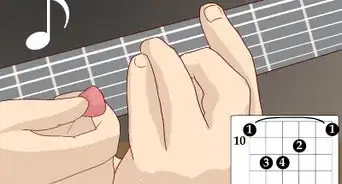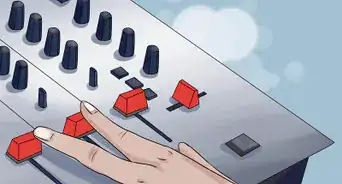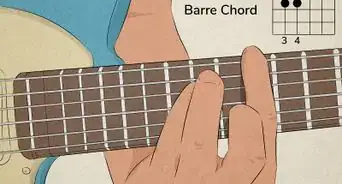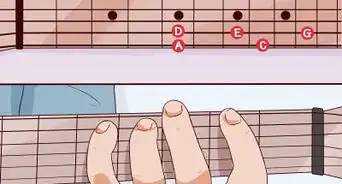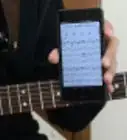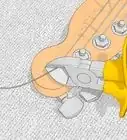X
This article was co-authored by Nate Savage. Nate Savage is a professional guitarist with over 16 years of experience teaching guitar to students around the world. His YouTube channel, Guitareo, has over 450,000 subscribers.
This article has been viewed 131,406 times.
A hammer-on is a technique almost every guitarist uses to greatly boost their playing speed, no matter what style of music you play. Hammer-ons are simply when you hit the string with your fretting hand, pressing down quickly so that the note rings out without ever having to strum. When combined with pull-offs, hammer-ons allow you to play many more notes without changing your picking rhythm or speed.
Steps
-
1Play one note, then use your fretting hand to rapidly smack another note for a hammer on. Start by just practicing this motion. With your hand around the guitar, quickly land a finger on the fret, as if you were about to play it. Practice making the note really sound out when you hit it. Get used to making the guitar sound out like this by "playing" several notes without ever picking.[1]
-
2Start with your index finger on a note. Simply play one note on the guitar, using your index finger so that the rest of your hand is open. It is much easier to hammer on to a note if it is nearby a note you're already holding down. Pick this note, letting it ring out.[2]Advertisement
-
3Land your ring finger two frets down to hammer on. Simply place the finger firmly down on another fret, staying on the same string as the note you picked. This note should sound out, but because you only picked the string once it will seamlessly transition from the first note you played.[3]
- Try to land your hammer on as close to the back of the fret (the side away from your strumming hand) to get the best sound.
-
4Adjust the power of your hammer on so that the picked and hammered note of the same volume. If you over-hit the note it will go sharp, sounding out with a weirdly higher pitch. Too soft and you can't hear it at all. The perfect middle ground is found by aiming for the same volume as a normally picked note.[4]
- You can use any finger to hammer on. However, it is usually easiest to learn with the ring and index fingers.
-
5Incorporate hammer-ons anywhere across the neck to increase your playing speed. Hammer-ons can come after notes, can "roll" down two or three notes at once (rapidly hammering on three frets with three fingers), and can be combined with pull-offs for dazzling speed.
- A pull-off is simply the reverse of a hammer on. While on two different frets on the same string, you slightly pluck as you remove your ring finger, sounding out the next fret you're holding or an open string.[5]
Advertisement
Community Q&A
-
QuestionHow do I hammer-on and pull-off repeatedly without losing the sound of the notes after a few seconds?
 Community AnswerTypically, that can only be done by sheer practice.
Community AnswerTypically, that can only be done by sheer practice.
Advertisement
References
- ↑ https://www.uberchord.com/blog/hammer-on-and-pull-off-guitar-techniques/
- ↑ https://www.dawsons.co.uk/blog/what-is-a-hammer-on
- ↑ https://www.cyberfret.com/guitar-techniques/hammer-ons-pull-offs/
- ↑ https://www.musicradar.com/how-to/guitar-basics-getting-started-with-hammer-ons
- ↑ http://www.guitarlessons.com/guitar-lessons/lead-guitar-quick-start-series/legato-hammer-ons-pull-offs/
- Videos from GuitarLessons.com
About This Article
Advertisement



